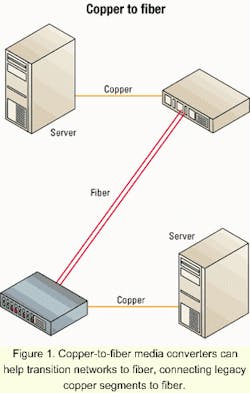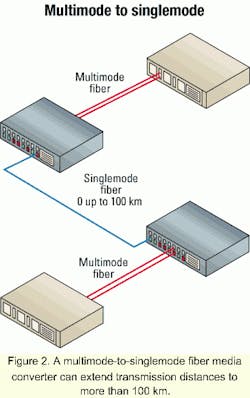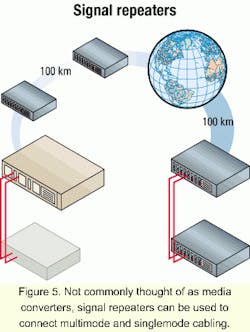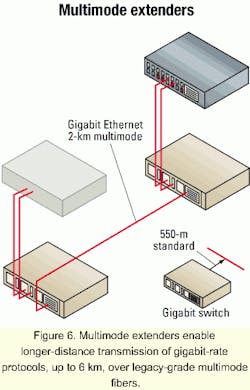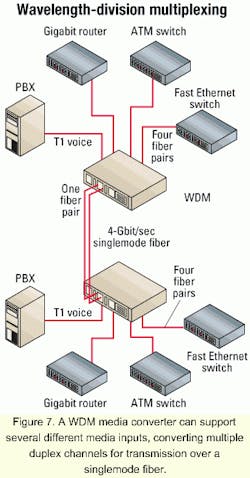Connecting something old with something new? Media converters can help.
These devices can integrate the existing infrastructure with newer fiber segments in the premises.
HANOCH ELDAR, Nbase-Xyplex
Increasing demand for bandwidth-intensive services and the need to push those services farther out into the extended LAN are driving the adoption of fiber into the network. But the reality of economics and limited resources necessitates a progressive, step-by-step transition to an all-optical infrastructure and the adoption of new technology. In this environment, there exists the need to seamlessly connect the old to the new, maintaining a highly integrated and fully managed network.
There is no question that LANs will have to convert to fiber. Experts, techno-futurists such as George Gilder, even your stockbroker, will tell you that fiber is the future. There are good reasons for this. With copper, we talk in terms of gigabits and meters. With fiber we talk in terms of terabits and kilometers. Simply stated, at some point, in terms of both bandwidth and distance, the limits of copper will be reached.
If it were possible, the choice would be to rip out all copper lines right now and replace them with fiber cabling. In reality, that is not practical. The obvious obstacle is cost. It's simply too expensive to make a wholesale upgrade to fiber. Most companies already have a substantial investment in equipment and infrastructure that still have a useful life.The strategy is to use fiber where possible and make the most of the fiber available. The challenge is in how that is accomplished. The use of managed fiber media converters is one solution. These devices can be used to integrate the copper infrastructure with fiber, creating a seamless network with end-to-end management.
At their base, media converters are devices that take an incoming signal from one type of media and convert it for transmission onto another type of media, for example, 100Base-TX (copper) to 100Base-FX (fiber). Media converters function at the physical layer and do not interfere with higher-layer protocols, making the whole conversion process transparent to devices on the network such as switches and routers and to the end user. Fiber media converters can be used almost anywhere to converge different media types without affecting network functionality.There are a wide variety of fiber media converters available in the market, and the chances are good that you will find one that suits your needs. Within each category of converter can be found support for just about any bit rate or protocol: Ethernet, Gigabit Ethernet, SONET/SDH, ATM, OC-N, Token Ring, Escon, Fibre Channel, T1/E1-the list goes on. Many media converters are available in different form factors from rack-mount module/chassis units to standalone models.
Copper-to-fiber media converters are key to the implementation of a good fiber-network strategy. These devices provide the ability to seamlessly connect legacy copper segments with newer fiber segments as shown in Figure 1. Copper-to-fiber media converters can be used to extend the LAN to great distances using installed or dark fiber. Common applications for these converters include converting twisted-pair or coaxial cabling to fiber cabling. Depending on the optics used, bit rate required, and quality of the fiber path, link distances of up to 100 km or more can be achieved when using singlemode fiber, making it possible to connect two very distant points on the same network.Multimode-to-singlemode fiber converters enable information technology managers to transparently connect multimode- and singlemode-fiber network segments (see Figure 2). Conversion from multimode to singlemode fiber, again, can extend transmission distances to over 100 km. These types of converters are often used to link Gigabit Ethernet switches and routers, and other high-speed network devices located in remote network segments.
Popular where additional fiber capacity is needed but not easily deployed, single-fiber, full-duplex converters (see Figure 3) use splitter/combiner technology to combine transmitter and receiver signals onto a single strand of singlemode fiber. This type of technology effectively doubles the capacity of available fiber, eliminating the need for the installation of additional cabling. The input media can be either copper or multimode fiber, depending on the protocol required.A variation of single-fiber converters will place transmitter and receiver signals on separate wavelengths. That eliminates the need for a splitter/combiner and gains back the decibel budget normally lost when it is used. Distances achieved with single-fiber converters will vary with type and configuration, but 60 km or more is not out of the question.
Redundant link converters, also known as self-healing converters, offer optical-link redundancy between points to protect against outages caused by cut fiber or accidental disconnects. These devices have one media input port (either copper or fiber) and two fiber outputs (normally singlemode). One output port functions as a primary path and the other as a secondary path. In the event of a dropped link on the primary fiber connection, the data path will switch over to the secondary connection (see Figure 4). Depending on the technology employed in the converter, the switchover can take just microseconds to complete, thereby avoiding an open shortest path first (OSPF) or spanning-tree induced topology change and eliminating any possible loss of data.
Redundant link fiber converters are well suited to mission-critical applications that demand maximum uptime such as in enterprise networks where the cost of downtime is high or for service-provider networks that must fulfill service-level agreements. For these types of applications, it is particularly desirable to use a converter that supports the simple network-management protocol (SNMP), so a trap can be set to alert the network manager in the event of a switchover. Some devices use either dual-fiber redundant links or single-fiber redundant links, with the former being able to span distances of 100 km or more.Many networks require link distances that extend beyond the normal limits of data transmission over fiber. For these networks, signal repeaters offer a solution. Signal repeaters retime and regenerate incoming data signals making multiple long-distance hops possible. While perhaps not commonly thought of as media converters, signal repeaters can be used to connect between multimode and singlemode cabling as well as for multimode-to-multimode or singlemode-to-singlemode connections. Repeaters can also be used to connect any combination of dual-fiber and single-fiber links (see Figure 5).
The emergence of high-speed communication technologies such as Gigabit Ethernet, Fibre Channel, and Ficon have presented a challenge for those wishing to integrate these protocols into networks using multimode fiber in the backbone. For protocols such as Gigabit Ethernet and Fibre Channel, the physical characteristics of multimode fiber place a severe limitation on link distance. The maximum distance allowed on multimode fiber by the Gigabit Ethernet standard (1000Base-LX) is 550 m, making its use in high-speed backbones impractical.
Multimode extender media converters use technology that minimizes the effect of modal dispersion, the factor that limits the transmission distance of high-speed data over multimode fiber. With these converters, new life can be given to an old fiber plant by allowing the transmission of gigabit-rate protocols as far as 6 km over legacy FDDI-grade multimode fiber (see Figure 6).
A key advantage of WDM is that it can easily and seamlessly be overlaid onto an existing network. WDM systems, like signal repeaters, are not normally thought of as media converters, but WDM technology applied to media converters can provide a real opportunity to maximize the use of fiber in the network.
Because a WDM system transmits and receives each data channel on a separate wavelength, the bit rate of each channel may be different. As such, a WDM media converter can be configured with several types of media input. For example, a WDM system can transmit or receive four Gigabit Ethernet data channels, eight Ethernet channels, two Escon channels, one OC-3 (155.52-Mbit/sec) channel, and one T1 channel. That's a total of 16 full-duplex data channels running over just one singlemode-fiber link. Since different wavelengths are used, there is not only a logical, but also a physical separation of data channels enhancing the level of network security (see Figure 7).
It is worth discussing the different types of WDM systems. DWDM systems are able to aggregate very high numbers of data channels onto a fiber link-128 channels and beyond-while reaching distances exceeding 80 km over singlemode fiber. This high concentration is achieved by keeping the separation between wavelengths to a minimum, 0.8 nm to be exact. But maintaining such precision comes at a premium price, as the optics and other components must meet very tight tolerances.Coarse wavelength-division multiplexing (CWDM) systems are relatively inexpensive by comparison. In these devices, the spacing between wavelengths is a roomy 20 nm or more, which means the optics and other components can accommodate a little more variance. CWDMs do not boast the same ultra-high concentration of data channels as DWDMs. While four-channel and eight-channel systems are common, now 16-channel units are available, with higher-density CWDM systems expected soon. Transmission distances of well over 60 km on singlemode fiber can be reached. In the final analysis, DWDM and CWDM systems each have their place. Which system is best will depend on the application.
A media converter, like any other network device, should be manageable from within a standard network management system such as SNMP. The ability to remotely monitor and manage all devices on the network, including media converters, is the best defense against trouble. Imagine receiving an e-mail on a cell phone indicating that one of the converter's cooling fans is spinning too slowly, or being able to detect a drop in optical power across a link before it becomes a problem. A media converter that does not support SNMP management can be a liability. With out SNMP management, the device becomes a black box on the network with no means to remotely monitor, control, or troubleshoot it should something go wrong.
A management feature of particular importance to fiber media converters is link integrity control. Without link integrity control, a situation may occur in which network segments on each side of a media-converter connection may become logically separated. For example, imagine converters being used to connect two routers that support OSPF. The converters take the connection from copper to fiber, then back to copper. If one of the copper links goes down, the fiber link may remain up because light is still being transmitted across the fiber by the laser. The result is that the opposite copper link also remains up and the second router never switches the data path to an alternate route. The same thing can happen between two switches that support the spanning tree.
With link integrity controls supported by both media converters, devices on each side of the connection are made aware of link loss. In the scenario above, when the copper link goes down, the media converter would automatically drop its fiber link. That in turn would cause the other converter to drop its copper link, and both routers would then detect link loss and switch to an alternate data route. An SNMP trap is also generated by the media converter to alert the network manager to the event.
When evaluating a media converter, it is important to consider the general robustness of its design. Does it offer redundant power supplies? Does it support the hot-swapping of modules? Can it be configured with AC and DC power supplies? Is it compliant with network equipment building standards? What are its environmental tolerances, for example, operating-temperature range and input power range? What types of chassis configurations and sizes are available? The answers to these questions will provide the information needed to make the best choice.
Media converters can provide solutions for merging copper to fiber and multimode-to-singlemode fiber, while extending data transmissions over great distances. These devices can multiplex data channels onto a fiber link or enable the deployment of redundant links for mission-critical applications. Media converters help to protect legacy equipment investment by transparently integrating newer segments of the network with existing elements. For all of these reasons, managed fiber media converters should be a key component of any fiber-optic deployment strategy.
Hanoch Eldar is president of NBase-Xyplex and chief architect of the Fiber Driver product line (Chatsworth, CA).
An expanded version of this article can be found on Lightwave's home page at www.light-wave.com.
